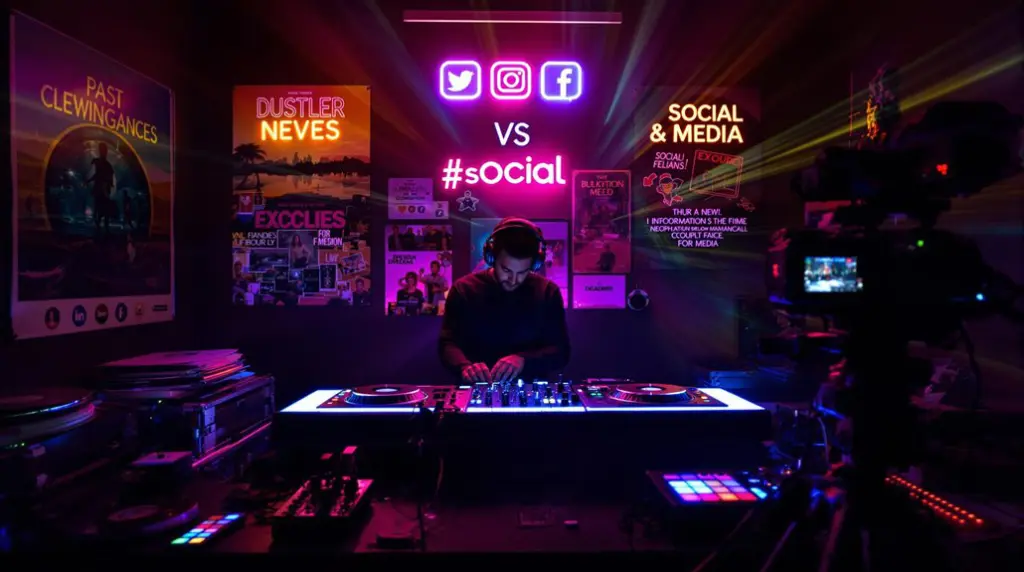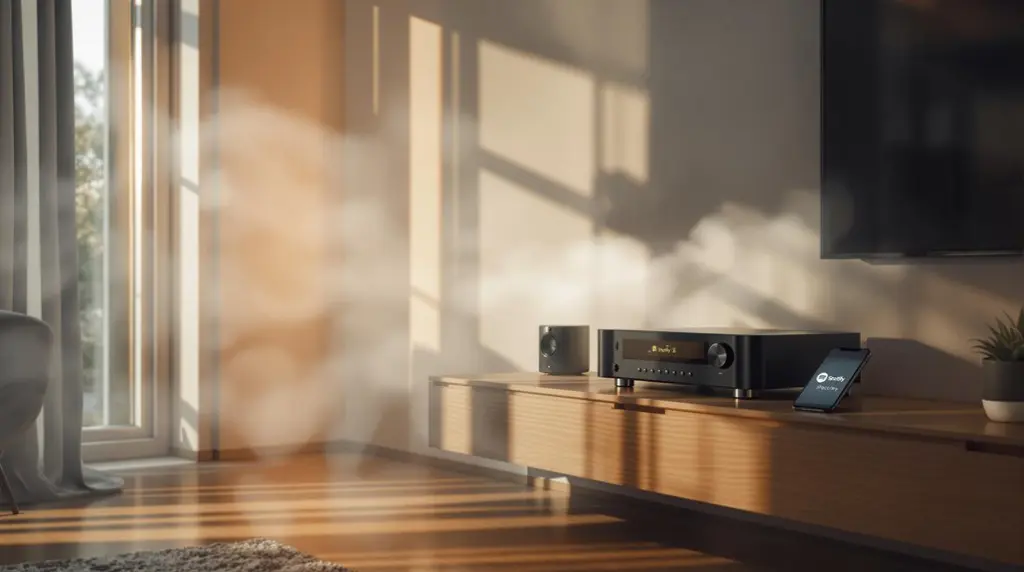To use Ableton Live effectively for live DJ performances, verify your laptop meets high specifications, like an Intel i7 processor and at least 16GB of RAM, paired with a high-quality external soundcard for low latency. Utilize the software’s Session View and MIDI mapping for dynamic control and seamless clip triggering. Organize and tempo-match your tracks, leveraging global tempo settings for smooth shift. Implement advanced sound processing and real-time manipulation using built-in plugins. Regular practice with diverse tracks and engaging with the DJ community can refine your skills. For thorough guidance on maximizing Ableton Live’s potential, further details await.
Key Takeaways
- Utilize Ableton’s Session View for efficient clip triggering and dynamic live performance control.
- Leverage MIDI mapping to enhance interaction with DJ controllers during sets.
- Set the global tempo to match your tracks for smooth transitions and consistent pacing.
- Use the crossfade feature to blend tracks seamlessly, maintaining continuous audio flow.
- Regularly practice with a DJ Mega Set template to refine timing and mixing skills.
Requirements for DJing in Ableton
When preparing for live DJ performances using Ableton Live, it is fundamental to make certain you meet several key requirements to confirm a seamless and professional experience. A significant component is your laptop specifications. Your laptop should have a robust processor, ideally an Intel i7 or higher, and at least 16GB of RAM to guarantee smooth operation.
Equally important is the soundcard quality; a high-quality external soundcard such as those from brands like RME or Focusrite is recommended. This assures low latency and superior audio fidelity, both essential for live DJ sets. Additionally, consider MIDI Mapping your controllers to enhance dynamic interaction during your performance.
In addition to hardware considerations, software is equally important. Verify you are running the latest version of Ableton Live Suite to leverage all the advanced features and updates. Effective track management is fundamental; create a dedicated folder on your hard drive for your mix files. This organization aids in quick access and reduces the risk of technical glitches during your performance.
Store all audio tracks intended for mixing as files on your hard drive for efficient manipulation within Ableton.
Lastly, invest in high-quality headphones and monitors. These are indispensable for precise sound monitoring and achieving accurate mixes during your live performances.
Advantages of Using Ableton
A myriad of advantages makes Ableton Live a compelling choice for live DJ performances, distinguishing it from traditional DJ software. One of the key benefits is its clip triggering capability, which allows DJs to initiate and manipulate multiple clips simultaneously. This feature facilitates dynamic and spontaneous live performances, enabling DJs to layer sounds in real-time for a more immersive auditory experience.
Additionally, Ableton’s integration with various DJ controllers guarantees seamless hardware compatibility, allowing for dynamic mixing and portability.
Ableton’s seamless integration of music creation and live performance greatly enhances workflow efficiency. DJs can compose, remix, and perform within the same environment, streamlining the entire process.
Advanced sound processing features, such as real-time audio manipulation and a diverse array of built-in plugins, open up creative possibilities that go well beyond basic mixing.
Designed with live performance in mind, Ableton Live offers session view and MIDI mapping, empowering DJs to customize their setups for maximum efficiency and creativity. Session view allows for an intuitive and flexible layout, while MIDI mapping provides extensive control over various parameters, enhancing performance adaptability.
Lastly, the ability to utilize complex audio routing and sidechain compression allows DJs to craft unique soundscapes and seamless changes. These features raise mixes, enabling DJs to deliver a performance that captivates the audience with innovative and intricate sound design.
Creating a DJ Mix
Creating a DJ mix in Ableton Live begins with selecting tracks that complement your desired genre and mix objectives, ensuring a seamless auditory experience.
Set the global tempo to match your chosen tracks, and import them into the Clip View for precise editing, looping, and arrangement.
Accurately position clips within the timeline to facilitate smooth crossfade shifts, enhancing the mix’s flow and cohesion.
Selecting Compatible Tracks
Consistently achieving a seamless and engaging DJ mix requires meticulous track selection that aligns with your mix’s overarching goals and desired genre. Confirming genre cohesion is paramount to maintaining a unified sound. Begin by curating tracks that resonate with your set’s theme, such as melodic or dark, to facilitate smooth shifts and maintain a thematic flow. Utilize platforms like Beatport to explore and filter tracks down to a refined selection, typically around ten, for purchase and download.
Once you have your initial selection, organize your tracks into cohesive groups within Ableton Live. This organization aids in delivering a fluid and engaging performance. Consider the energy and mood of each track, retaining those that offer unique mixing opportunities or elements of humor to captivate your audience.
To manage your music library effectively, keep a temporary storage area for newly acquired tracks. This allows for easy access and categorization before integrating them into your main library. This method confirms that your selection process remains streamlined and your live set maintains its intended direction.
| Track Selection Tips | Action | Benefit |
|---|---|---|
| Align with mix goals | Select genre-compatible | Confirm genre cohesion |
| Curate from Beatport | Filter to top ten tracks | Refined selection |
| Temporary storage | Organize before library | Easy access during sets |
Smooth Crossfade Transitions
Achieving smooth crossfade shifts in Ableton Live is essential for crafting a professional DJ mix that engages your audience. To begin with, guarantee that your mix tempo matches the selected tracks. Tempo matching is vital for seamless integration, preventing any jarring changes during your performance.
Utilize the Clip View for precise clip editing and looping of your tracks. Positioning clips accurately will facilitate effortless changes between songs, allowing for a fluid and engaging mix.
In the mixer section, experiment with the crossfade feature to blend audio tracks gradually rather than abruptly. This technique helps maintain a continuous flow, enhancing the listener’s experience.
Simultaneously, adjust volume and EQ levels during live mixing to guarantee a balanced audio output. Properly managed levels are important for smooth crossfades, preventing any sudden spikes or drops in sound.
Regular practice within the DJ Mega Set template can greatly refine your timing and overall mixing skills. This consistent rehearsal will lead to a more polished live performance, allowing you to execute smooth crossfades with confidence.
Recording Your DJ Mix
Assuring ideal sound quality and control, the first step to recording your DJ mix in Ableton Live involves connecting your headphones and turntables, allowing for proper monitoring throughout the session.
To begin, access the Preferences menu and configure your audio settings. Confirm that your input and output devices are correctly set up to facilitate seamless live recording. This foundational step is essential for capturing a clean and professional mix. Remember to check system requirements to confirm your laptop is compatible with Ableton Live, especially if you’re using advanced features.
Next, create a dedicated audio track specifically for recording your mix. Enable the Record Arm button on this track to prepare it for capturing your performance. This setup guarantees that all your mix techniques, changes, and effects are recorded accurately.
To initiate the recording, click the global record button in Ableton’s transport bar. This action will commence the live recording of your DJ mix session. As you perform, real-time monitoring through your headphones allows for immediate adjustments, assuring the best possible output.
Once your mix session is complete, stop the recording. You can then export the recorded session to a preferred file format, such as WAV or MP3, making it ready for sharing or promotional use.
This streamlined process in Ableton Live guarantees your DJ mix is captured with precision and clarity.
Effective DJing Tips
Maximizing your effectiveness as a DJ in a live setting requires strategic planning and mastery of both your equipment and your craft. To achieve seamless live performances, focus on the following key areas:
1. Upgrade Your Hardware: Confirm your computer’s hardware, specifically RAM and CPU, is robust enough to handle intensive Ableton Live sessions. Enhanced performance minimizes glitches, allowing for uninterrupted live DJ sets.
A high-powered processor and ample RAM are essential for avoiding latency issues, guaranteeing stability during performances.
2. Utilize MIDI Controllers: Devices like the APC40 or Novation Launchpad greatly improve your control over effects and live mixing.
Experimenting with these controllers can boost your ability to manipulate tracks dynamically and maintain fluid shifts, vital for keeping your audience engaged. MIDI mapping provides personalized control over software features, improving overall mixing efficiency.
3. Regular Practice: Consistently practicing with a diverse range of tracks is essential.
Focus on key elements such as volume and bass adjustments to refine your sound quality. Booking a DJ studio can provide access to professional equipment and an environment conducive to honing your skills, guaranteeing you are well-prepared for any live performance.
Additionally, archiving previous sets can serve as a valuable reference, enabling you to identify tracks that resonate with your audience.
This approach not only polishes your technique but also improves audience engagement through memorable and unique performances.
Community Interaction and Feedback
Engaging with your audience through social media platforms is essential for gathering insights on your DJing style and track organization, which can be pivotal for refining your performances.
Encouraging followers to provide constructive criticism in the comments section fosters a productive exchange that enhances your track selection and technical skills.
Regularly updating your online portfolio with new content also helps in maintaining a fresh and engaging presence.
Actively participating in these discussions not only improves your own abilities but also strengthens community interaction and broadens perspectives on live DJ performances.
Engage With Followers
In the domain of live DJ performances, leveraging social media for follower engagement is paramount for cultivating a dynamic and interactive community.
This engagement not only provides valuable audience insights but also establishes a feedback loop essential for refining your DJing style and track selection. Constructive feedback from your audience can be instrumental in enhancing your skills and performance approach.
To effectively engage with your followers, consider the following practical strategies:
- Social Media Posts: Regularly share updates, behind-the-scenes content, and performance clips. This sparks discussions and provides insights into your audience’s perceptions.
- Inviting Feedback: Encourage your followers to provide feedback on your sets and track choices. Create polls or ask direct questions to foster interaction and gather constructive criticism.
- Live Q&A Sessions: Host live sessions where followers can ask questions and share their thoughts. This interaction builds a collaborative environment, promoting shared learning experiences.
Address Track Organization
Building on the significance of engaging with your followers, meticulous track organization is another crucial aspect of delivering compelling live DJ performances. Effective track categorization is essential for streamlining your selection process during live sets. By organizing tracks into thematic groups, such as melodic or dark, you can guarantee a coherent flow that aligns with the intended direction of your performance.
Utilizing an archive of previous sets enables efficient track selection and helps maintain a collection of unique tracks that can inject humor or creativity into future performances. Regularly filtering and categorizing newly discovered tracks from platforms like Beatport guarantees your library remains fresh and aligned with your evolving performance goals.
Audience engagement extends beyond live performances; interacting with your community on social media can offer valuable insights into your track organization. Inviting feedback from your followers allows you to refine your DJing style and approach, ensuring that your sets resonate more deeply with your audience.
Additionally, embracing community discussions provides diverse perspectives on track organization, which can help you develop a more effective and engaging DJing strategy.
Encourage Constructive Criticism
Fostering a dynamic and interactive relationship with your audience is pivotal in refining your DJ performances. Engaging your audience on social media by sharing clips of your DJ sets and inviting comments can initiate discussions about your mixing techniques and track selection.
Actively seeking constructive criticism from your followers will help identify areas for improvement, allowing you to refine your performance approach effectively.
To harness the power of community feedback:
- Share Content Regularly: Post snippets of your sets, focusing on different aspects such as mixing changes or track selections. This invites specific feedback.
- Ask Targeted Questions: Engage your audience by asking questions about your track organization or mixing strategies. This can prompt more detailed and actionable feedback.
- Acknowledge Feedback: Show appreciation for the input you receive by responding to comments. This not only strengthens your relationship with your followers but also fosters a supportive environment for shared learning.
Utilizing the feedback received, experiment with different mixing techniques and track choices to enhance the overall quality of your performances.
Encouraging open dialogue and actively responding to your community can greatly improve your DJing skills and guarantee your sets resonate more deeply with your audience.
Frequently Asked Questions
Can You Use Ableton Live for DJING?
Yes, Ableton Live is highly suitable for DJing, offering robust live remixing capabilities and advanced audio effects. Its clip-based interface and seamless integration make it a preferred tool for DJ/producers seeking creative control during performances.
Can You Perform Live With Ableton?
Yes, you can perform live with Ableton Live. It offers advanced live performance techniques and versatile audio routing options, allowing for creative and dynamic sets. Mastering its features and integrating MIDI controllers can enhance your live shows.
Is Ableton a Good DJ Software?
Ableton features a robust DJ workflow, making it an exceptional choice for live performances. Its clip-based approach, advanced effects, and MIDI controller compatibility provide unparalleled flexibility and creativity, surpassing traditional DJ software in sound design and real-time track manipulation.
What DJ Controllers Work With Ableton?
Popular DJ controllers compatible with Ableton Live include the Novation Launchpad, Akai APC40, and Native Instruments Traktor Kontrol S4. These provide seamless integration and extensive MIDI mapping capabilities, ensuring ideal controller compatibility for professional live performances.
Conclusion
Utilizing Ableton Live for DJ performances offers numerous advantages, including unparalleled versatility and creative control. By understanding the requirements, mastering mix creation, and effectively recording performances, DJs can enhance their craft. Implementing practical tips and engaging with the DJ community can further refine skills and improve audience interaction. Mastery of Ableton Live allows DJs to push the boundaries of traditional DJing, fostering innovation and excellence in live performance settings.




